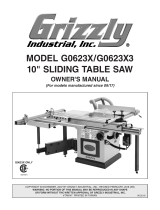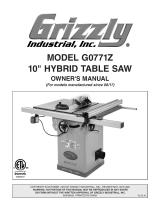
Table of Contents
INTRODUCTION ............................................... 2
Machine Description
...................................... 2
Contact Info.................................................... 2
Manual Accuracy
........................................... 2
Controls & Components
................................. 3
Glossary Of Terms
......................................... 6
Sliding Table Saw Capacities
........................ 7
Machine Data Sheet
...................................... 8
SECTION 1: SAFETY
..................................... 11
Safety Instructions for Machinery
................ 11
Additional Safety for Sliding Table Saws
..... 13
Additional Safety for Sliding Table Saws
..... 13
Preventing Kickback
.................................... 14
Protecting Yourself From Kickback.............. 14
SECTION 2: POWER SUPPLY
...................... 15
440V Conversion
......................................... 16
SECTION 3: SETUP
....................................... 18
Needed for Setup
......................................... 18
Unpacking
.................................................... 18
Hardware Recognition Chart
....................... 19
Inventory
...................................................... 20
Cleanup
........................................................ 22
Site Considerations
...................................... 23
Lifting & Placing Saw
................................... 24
Assembly
..................................................... 25
Dust Collection
............................................. 38
Power Connection........................................ 39
Test Run
...................................................... 41
Recommended Adjustments
........................ 42
SECTION 4: OPERATIONS
........................... 43
Operation Overview
..................................... 43
Workpiece Inspection................................... 44
Through & Non-Through Cuts
..................... 44
Blade Guard
................................................. 45
Riving Knife
.................................................. 46
Blade Requirements
.................................... 47
Blade Selection
............................................ 47
Changing Speed
.......................................... 49
Changing ..................................................... 50
Main Blade
................................................... 50
Replacing & Aligning Scoring Blade
............ 51
Setting Up
................................................... 54
Crosscut Fence
............................................ 54
Rip Cutting
................................................... 57
Crosscutting
................................................. 59
Miter Cutting................................................. 61
Dado Cutting
................................................ 62
Rabbet Cutting
............................................. 63
Narrow-Rip Auxiliary Fence & Push Block
.. 64
SECTION 5: ACCESSORIES
......................... 66
SECTION 6: MAINTENANCE
......................... 69
Schedule
...................................................... 69
Cleaning & Protecting
.................................. 69
Lubrication
................................................... 70
SECTION 7: SERVICE
................................... 71
Troubleshooting
........................................... 71
Belt Service
.................................................. 73
Blade Tilt Calibration
.................................... 75
Sliding Table Parallel Adjustment
................ 76
Sliding Table Movement Adjustment
........... 77
Squaring Crosscut Fence to Blade
.............. 77
Riving Knife Mounting Block
........................ 79
Calibrating Rip Fence
.................................. 80
SECTION 8: WIRING
...................................... 81
Wiring Safety Instructions
............................ 81
Wiring Overview
........................................... 82
Component Location Index
.......................... 83
Control Panel Wiring
.................................... 84
220V Electrical Panel Wiring
....................... 85
440V Electrical Panel Wiring
....................... 86
Scoring Motor Wiring
................................. 88
Main Motor Wiring ....................................... 89
Master Power Switch Wiring
....................... 90
SECTION 9: PARTS
....................................... 91
Body
............................................................. 91
Main Tables
................................................. 93
Control Panel
............................................... 94
Blade Enclosure
........................................... 95
Main Motor
................................................... 96
Main Blade Arbor
......................................... 97
Blade Tilt System
......................................... 98
Blade Elevation System
............................... 99
Scoring Blade Arbor
................................... 100
Scoring Blade Adjustment System
............ 101
Scoring Blade Motor
.................................. 102
Crosscut Swing-Arm
.................................. 103
Crosscut Table
........................................... 104
Crosscut Fence
.......................................... 105
Rip Fence................................................... 106
Sliding Table
.............................................. 107
Blade Guard
............................................... 108
Sliding Table Accessories
.......................... 110
Electrical
.................................................... 111
Labels & Cosmetics
................................... 112
WARRANTY & RETURNS
........................... 117
























